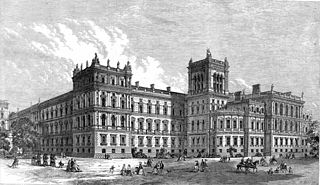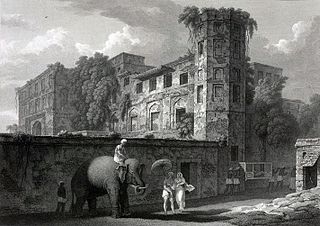 W
WThe British Indian passport was a passport, proof of national status and travel document issued to British subjects of the British Indian Empire, British subjects from other parts of the British Empire, and the subjects of the British protected states in the Indian subcontinent. The title of the state used in the passport was the "Indian Empire", which covered all of India, Pakistan, Bangladesh, and Burma.
 W
WThe Chamber of Princes was an institution established in 1920 by a royal proclamation of King-Emperor George V to provide a forum in which the rulers of the princely states of India could voice their needs and aspirations to the colonial government of British India. It survived until the end of the British Raj in 1947.
 W
WBritish trading posts in India were first established by the East India Company (EIC) early in the seventeenth century, which quickly evolved into larger colonies covering a significant part of the subcontinent. Early settlements or factories included Masulipatnam (1611) and Madras (1640) in the south, Surat (1612) in the west, and modern-day Kolkata (1698–99) in the east. These colonies gave rise to Madras Presidency, Bombay Presidency, and Bengal Presidency, and each Presidency had a separate coinage and monetary system. In time, the EIC adopted a unified system of coinage throughout all British possessions in India and the older Presidency system was discontinued. After the Indian Rebellion of 1857, control of EIC territories passed to the British Crown. Coinage issued after 1857 were under the authority of the monarch as India became part of the British Empire. With the Royal Titles Act 1876, Victoria took the title "Empress of India", so in 1877 coin inscriptions changed from Victoria Queen to Victoria Empress. There was a transition period after India gained independence on 15 August 1947, and the first set of republic India coins were issued in 1950.
 W
WDuring the period of the Company rule in India and the British Raj, the Commander-in-Chief, India was the supreme commander of the British Indian Army. The Commander-in-Chief and most of his staff were based at GHQ India, and liaised with the civilian Governor-General of India. Following the Partition of India in 1947 and the creation of the independent dominions of India and Pakistan, the post was abolished. It was briefly replaced by the position of Supreme Commander of India and Pakistan before the role was abolished in November 1948. Subsequently, the role of Commander-in-Chief was merged into the offices of the Commanders-in-Chief of the independent Indian Army and Pakistan Army, respectively, before becoming part of the office of the President of India from 1950 and of the President of Pakistan from 1956.
 W
WThe Council of India was the name given at different times to two separate bodies associated with British rule in India.
 W
WThe Delhi Durbar was an Indian imperial-style mass assembly organized by the British at Coronation Park, Delhi, India, to mark the succession of an Emperor or Empress of India. Also known as the Imperial Durbar, it was held three times, in 1877, 1903, and 1911, at the height of the British Empire. The 1911 Durbar was the only one that a sovereign, George V, attended. The term was derived from the common Mughal term durbar.
 W
WDurbar is a Persian-derived term meaning the kings’ or rulers’ noble court or a formal meeting where the king held all discussions regarding the state. It was used in India for a ruler’s court or feudal levy as the latter came to be ruled and later administered by foreigners. A durbar may be either a feudal state council for administering the affairs of a princely state, or a purely ceremonial gathering, as in the time of the British Empire in India.
 W
WThe India Office was a British government department established in London in 1858 to oversee the administration, through a Viceroy and other officials, of the Provinces of British India. These territories comprised most of the modern-day nations of Indian Subcontinent as well as Yemen and other territories around the Indian Ocean. The department was headed by the Secretary of State for India, a member of the British cabinet, who was formally advised by the Council of India.
 W
WThe Interim Government of India, also known as the Provisional Government of India, formed on 2 September 1946 from the newly elected Constituent Assembly of India, had the task of assisting the transition of British India to independence. It remained in place until 15 August 1947, the date of the independence of India, and the creation of Pakistan.
 W
WMunshi is a Persian word, originally used for a contractor, writer, or secretary, and later used in the Mughal Empire and India for native language teachers, teachers of various subjects, especially administrative principles, religious texts, science, and philosophy and were also secretaries and translators employed by Europeans.
 W
WThe President of the Board of Control was a British government official in the late 18th and early 19th century responsible for overseeing the British East India Company and generally serving as the chief official in London responsible for Indian affairs. The position was frequently a cabinet level one. The position was abolished in 1858 with the abolition of the East India Company. It was succeeded by the new position of Secretary of State for India.
 W
WHis Majesty's Principal Secretary of State for India, known for short as the India Secretary or the Indian Secretary, was the British Cabinet minister and the political head of the India Office responsible for the governance of the British Indian Empire, Aden, and Burma. The post was created in 1858 when the East India Company's rule in Bengal ended and India, except for the Princely States, was brought under the direct administration of the government in Whitehall in London, beginning the official colonial period under the British Empire.
 W
WThe Star of India refers to a group of flags used during the period of the British Raj in the Indian subcontinent. India had a range of flags for different purposes during its existence. The Princely states had their own flags which were to be flown alongside the British flag as a symbol of suzerainty. The official state flag for use on land was the Union Flag of the United Kingdom and it was this flag that was lowered on Independence Day in 1947. The flag of the governor-general of India was defaced with the Star of India. The civil ensign and naval ensign were the Red Ensign or Blue Ensign, respectively, defaced with the Star of India emblem.
 W
WThe Survey of India is India's central engineering agency in charge of mapping and surveying. Set up in 1767 to help consolidate the territories of the British East India Company, it is one of the oldest Engineering Departments of the Government of India. Its members are from Survey of India Service cadre of Civil Services of India and Army Officers from the Indian Army Corps of Engineers. It is headed by the Surveyor General of India. At present, Survey of India is headed by Naveen Tomar.
 W
WThe Talukdars or Talukders, were aristocrats who formed the ruling class during the Delhi Sultanate, Bengal Sultanate,Mughal Empire and British times. They were owners of a vast amount of lands, consistently hereditary, and were responsible for collecting taxes. The Taluqdars played helpful roles in the progression of Indian architecture and Indian economy during the reign of Emperor Shah Jahan and Aurangzeb, particularly in Bengal Subah, the most economically developed province in South Asia.